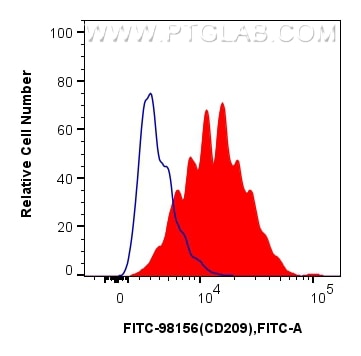Tested Applications
| Positive FC detected in | human monocyte-derived immature dendritic cells |
Recommended dilution
| Application | Dilution |
|---|---|
| Flow Cytometry (FC) | FC : 5 ul per 10^6 cells in 100 μl suspension |
| This reagent has been pre-titrated and tested for flow cytometric analysis. The suggested use of this reagent is 5 ul per 10^6 cells in a 100 µl suspension or 5 ul per 100 µl of whole blood. | |
| Sample-dependent, Check data in validation data gallery. | |
Product Information
FITC-98156 targets CD209 in FC applications and shows reactivity with human samples.
| Tested Reactivity | human |
| Host / Isotype | Rabbit / IgG |
| Class | Recombinant |
| Type | Antibody |
| Immunogen | CD209 fusion protein Eg0062 Predict reactive species |
| Full Name | CD209 molecule |
| Calculated Molecular Weight | 404 aa, 45.7 kDa |
| GenBank Accession Number | BC110615 |
| Gene Symbol | CD209 |
| Gene ID (NCBI) | 30835 |
| Conjugate | FITC Plus Fluorescent Dye |
| Excitation/Emission Maxima Wavelengths | 495 nm / 524 nm |
| Form | Liquid |
| Purification Method | Protein A purification |
| UNIPROT ID | Q9NNX6 |
| Storage Buffer | PBS with 0.09% sodium azide and 0.5% BSA, pH 7.3. |
| Storage Conditions | Store at 2-8°C. Avoid exposure to light. Stable for one year after shipment. |
Background Information
CD209 (DC-SIGN, CLEC4L) is a C-type lectin receptor that is involved in the innate immune system and recognizes numerous evolutionarily divergent pathogens, including bacteria, viruses, and parasites. CD209 is preferentially expressed on dendritic cells (DCs). It mediates transient adhesion of DCs with T cells. It has been reported that CD209 plays a role in capture and transmission of HIV from DC to T cells (PMID: 10721995).
Protocols
| Product Specific Protocols | |
|---|---|
| FC protocol for FITC Plus CD209 antibody FITC-98156 | Download protocol |
| Standard Protocols | |
|---|---|
| Click here to view our Standard Protocols |



